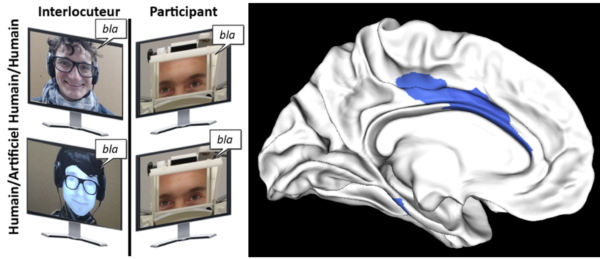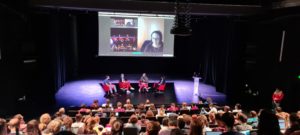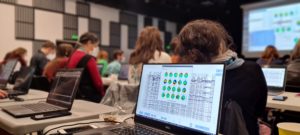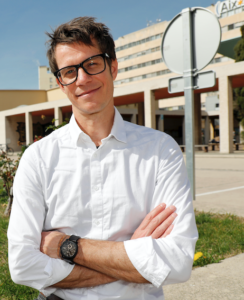|
Dear members of the ILCB,
It’s my pleasure to see that ILCB is back at cruising altitude with a series of excellent seminars coming up almost every Friday. PhD students and postdocs get a special moment with the invited speaker to discuss their work but please keep in mind that the lunch talks are for all of us. Many of these events are still held through videoconferencing. For a livelier experience, we suggest organizing watch meetings with your teams or labs. So please join us on these various occasions and feel free to invite speakers.
As mentioned in our last newsletter, we will renew the cross-cutting topics in 2022. A cross-cutting topic group identifies an important scientific question that could be tackled from an interdisciplinary perspective within the next 4 years at ILCB. Don’t hesitate to talk to colleagues around you about this.
Best wishes,
Johannes |
| |
|
"It is, indeed, the default view among us psycholinguists and our students that our science took off during the 1950s. [...]

Its empirical roots go back to the late eighteenth century. It was an established discipline a century later and it was a booming science during the first half of the twentieth century."
photo (c) Max-Planck-Gesellschaft
Willem J. M. Levelt in the preface of A History of Psycholinguistics. The Pre-Chomskyan Era, Oxford University Press, 2013. |
| |
|
Linguistic et neuro-physiological comparison of human-human and human-robot conversations |
|

A body of natural conversations helped develop lexical alignment between participants and two types of interlocutors: a human and a robot. fMRI data indicates a negative correlation of this alignment with cingulate cortex activity, suggesting a reduction in internal resource use when the participant's lexicon is aligned to that of the speaker
Hallart, C., Maes, J., Spatola, N., Prévot, L., & Chaminade, T. (2021). Revue TAL, ATALA (Association pour le Traitement Automatique des Langues), 2021, Dialogue et systèmes de dialogue / Dialogue and dialogue systems, 61 (3), pp.69-93.
|
|
|
| |
|
Ana Zappa
|
|
Ana ZAPPA received the 2020 Best Thesis Award from the Language, Cognition, and Education doctoral school (ED 356). Her thesis, entitled “Embodied semantics put to the test: electrophysiological evidence from virtual reality and classical environments“, was conducted… |
|
|
|
|
| |
|
Frequency Selectivity of Persistent Cortical Oscillatory Responses to Auditory Rhythmic Stimulation |
|
Jacques Pesnot Lerousseau, Agnès Trébuchon, Benjamin Morillon, & Daniele Schön |
|
|
|
Overpressure on fingertips prevents state estimation of the pen grip force and movement accuracy |
|
Jérémy Danna, Mathilde Nordlund, Didier Louber, Simon Moré, & Laurence Mouchnino
. |
|
|
|
The dynamics of reading complex words: evidence from steady-state visual evoked potentials |
|
Elisabeth Beyersmann, Veronica Montani, Johannes C Ziegler, Jonathan Grainger, & Ivilin Peev Stoianov |
|
|
|
The Same Ultra-Rapid Parallel Brain Dynamics Underpin the Production and Perception of Speech |
|
Amie Fairs, Amandine Michelas, Sophie Dufour, & Kristof Strijkers |
|
|
| |
|
Source localisation of motor-related EEG activity in speech perception and production
|
|
Kristof Strijkers and Noël Nguyen (LPL) |
|
|
|
Teaching an old word new tricks? How bilinguals fine-tune their mental lexicon
|
|
Isabelle Darcy (Chaire IMéRA) and Cheryl Frenck-Mestre (LPL) |
|
|
|
Impact de l’alerte sur l’attention volontaire ou involontaire
|
|
Aurélie Bidet-Caudet (INS) |
|
|
| |
|
The 5th edition of the CuttingEEG conference was held at Le Cube (on AMU's Aix-en-Provence campus) on October 4-7, 2021. It was impulsed by the CuttingEEG organization with the local committee conducted by Anne-Sophie Dubarry and Clement François (LPL). It was supported by several Aix-Marseille institutional sponsors, including the ILCB.

The conference was the first in person event for many of the 202 attendees and speakers since the start of the Covid sanitary crisis. The event featured 14 keynote talks, 12 hands-on tutorials, and 80 posters presentations, all focusing on the latest EEG and MEG developments. The audience was international, with participants and speakers coming from 23 countries, and 51 distant attendees following the hybrid broadcast.

|
| |
|
To become a reader, we must learn to relate arbitrary visual symbols (letters) to the sounds of spoken language. After a few years of training at school, this correspondence between visual words and sounds of language becomes so automatic that the expert reader can literally "hear with his/her eyes." But can we facilitate this learning? Could other senses be allies?

Felipe Pegado (LPC) will present his research on this topic in the form of a 15 minute stand up at the next Neurostories event held in Marseille on Nov. 25th, where
"quatre chercheurs et une auteure renverseront votre vision des 5 sens et vous en feront découvrir de nouveaux !"
photo (c) drossi @ laprovence |
| |
|
Dec. 3rd, 12:00 - 16:00
Andrea E. Martin, Max Planck Institute for Psycholinguistics (Nijmegen)
Boundary conditions for language in biological and artificial neural systems |
| |
ILCB is affiliated to Aix-Marseille Université, CNRS, INSERM, and Université d'Avignon
5 avenue Pasteur 13604 Aix-en-Provence Cedex 1 B.P. 80975 +33 (0)4 13 55 36 31
Copyright © ILCB 2021
| |
|